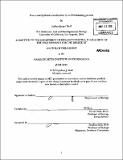Post-transcriptional coordination by an RNA-binding protein
Author(s)
Wolf, Joshua Jaeger
DownloadFull printable version (11.84Mb)
Other Contributors
Massachusetts Institute of Technology. Dept. of Biology.
Advisor
Gerald Fink.
Terms of use
Metadata
Show full item recordAbstract
RNA-binding proteins can regulate the stability, localization, and translation of their target mRNAs. Post-transcriptional regulation can orchestrate dynamic changes in gene expression, and can coordinate multiple cellular processes in response to various stimuli. Filamentous growth in Saccharomyces cerevisiae is a morphogenetic switch that occurs in response to nitrogen starvation and requires alterations in cell growth, cell cycle, and cell wall functions. Tyl element retrotransposition is also induced under conditions of nitrogen starvation. I describe a role for the RNA-binding protein Khdl in regulating these two responses to environmental stress through its mRNA targets. I identified the RNA targets of Khdl using in vivo crosslinking and immunoprecipitation (CLIP), combined with deep sequencing. This produced a high-resolution map of Khdl binding sites across the transcriptome, and provided unprecedented insight into its biological functions. Khdl regulates multiple post-transcriptional regulatory loops to coordinate the components of filamentous growth and Tyl retrotransposition. Although similar mechanisms were known to transcriptionally regulate these processes, the posttranscriptional coordination is a novel discovery. The feed-forward regulation that Khdl confers on FLO11, which encodes a protein required for filamentous growth, enables asymmetric expression between mother and daughter cells to switch between filamentous and yeast form growth. In this thesis, I describe regulation of gene expression by RNA-binding proteins, methods to identify their target transcripts and recognition sequences, the KH domain, known functions of Khdl, and the phenotypes it coordinates. My work represents the first application of CLIP to budding yeast, and the growing understanding of RNA-binding proteins in this organism facilitated the placement of Khdl into its posttranscriptional regulatory network. While many questions remain regarding the role Khdl plays in regulating cellular activities, this thesis addresses its direct role in key processes.
Description
Thesis (Ph. D.)--Massachusetts Institute of Technology, Dept. of Biology, 2010. Cataloged from PDF version of thesis. Includes bibliographical references.
Date issued
2010Department
Massachusetts Institute of Technology. Department of BiologyPublisher
Massachusetts Institute of Technology
Keywords
Biology.